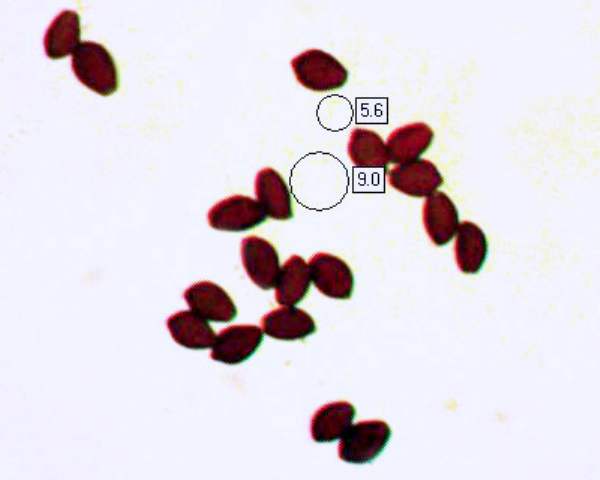Coprinellus micaceus (Bull.) Vilgalys, Hopple & Jacq. Johnson - Glistening Inkcap
Phylum: Basidiomycota - Class: Agaricomycetes - Order: Agaricales - Family: Psathyrellaceae
Distribution - Taxonomic History - Etymology - Identification - Culinary Notes - Reference Sources
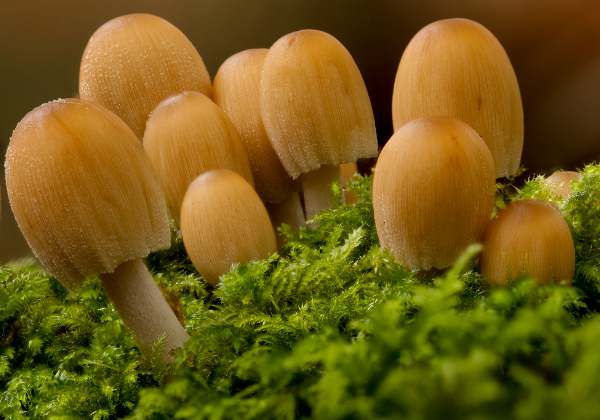
From tree stumps or buried wood of broadleaf trees, Coprinus micaceus, formerly known as the Mica Inkcap but now called the Glistening Inkcap, arises in small to medium-sized clumps from spring until early winter. This edible mushroom is potentially poisonous if collected from roadsides or polluted land, where the mycellium can bioaccumulate heavy metals such as cadmium and lead; this results in the mushrooms containing high concentrations of these toxins.
Distribution
Common in Britain and Ireland and throughout Europe and North America, the Glistening Inkcap is truly a cosmopolitan mushroom, being found also in most parts of Asia and in South America and Australia. Coprinellus micaceus usually appears in quite large clusters and very rarely as solitary specimens.
Taxonomic history
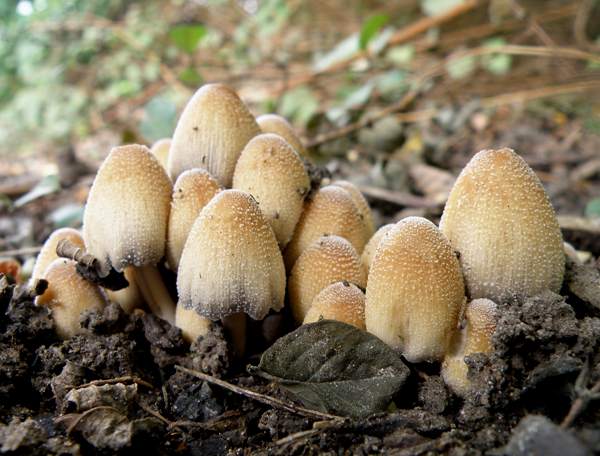
The Glistening Inkcap was first described scientifically in 1786 by Jean Baptiste Francois Pierre Bulliard, who gave it the scientific name Agaricus micaceus. (Vast numbers of gilled fungi were dumped into the Agaricus genus in the early days of fungal taxonomy; most have since been moved to other genera leaving in the present-day Agaricus genus a much smaller number of gilled mushrooms that are sometimes referred to as the 'true mushrooms'.) The great Swedish mycologist Elias Magnus Fries later renamed this species as Coprinus micaceus. It was known by that name until 2001 when, as a result of molecular (DNA) analysis, the Coprinus genus was shown to contain groups of fungi with only distant relationships to one another, and the earlier Coprinus group was dismantled with the Glistening Inkcap being moved into the genus Coprinellus. (Coprinus comatus, the Shaggy Inkcap, plus three other rare fungi are all that remains in the formerly large Coprinus genus.)
Synonyms of Coprinellus micaceus include Agaricus micaceus Bull., and Coprinus micaceus (Bull.) Fr.
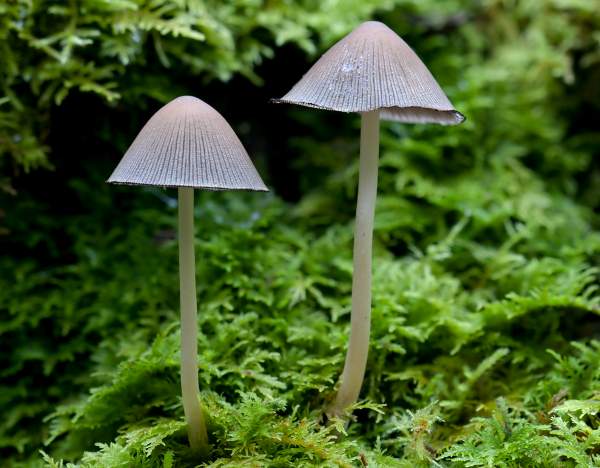
As Glistening Inkcaps mature the caps become bell shaped and then begin deliquescing from the margin inwards, as seen here.
Etymology
The generic name Coprinellus indicates that this mushrooms genus appears to be (or was thought to be) similar to fungi in the genus Coprinus, which literally means 'living on dung' - that's true of quite a few of the inkcaps but not particularly apt for this and several other Coprinellus species. The suffix -ellus indicates fungi that produce rather smaller fruitbodies than those of Coprinus species. The specific epithet micaceus means 'similar to grains of salt (or mica)' and refers to the tiny granules (veil fragments) that glisten like specks of mica on the surfaces of immature caps. In wet weather these granules are sometimes washed away so that the surfaces mature caps become entirely smooth rather than granular.
Common names change with time and location. In America the terms Inky Cap or Inky-cap are most commonly used, while in many older field guides published in Britain you are likely to see Ink Cap or Ink-cap rather than Inkcap.
Identification guide
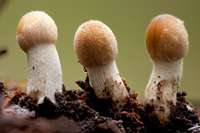 |
CapCovered at first in tiny white granules - the remains of the veil - the egg-shaped caps of Coprinellus micaceus become bell shaped and lose their salt-like grains of velum as they age. The caps are typically 2 to 4cm tall and of similar diameter when they open out. The cap colour is ochre-brown, with a russet central 'eye', and turns grey-brown as it ages. Glistening Inkcaps are somewhat hygrophanous: they change colour depending on whether they are dry or moist, darkening when the air is damp. |
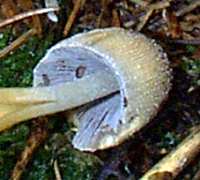 |
GillsThe gills of the Glistening Inkcap are white, turning purple-brown and then blackening before deliquescing (autodigesting and becoming a black inky fluid). StemThe white stem is brownish at the base, typically 2 to 5mm in diameter and 4 to 10cm tall. |
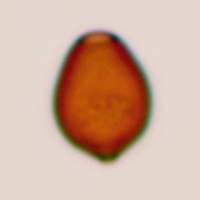 |
SporesEllipsoidal to mitriform (shield-shaped), smooth, 7-10 x 4.5-6µm; with a central germ pore. Spore printVery dark brown or black. |
Odour/taste |
Not distinctive. |
Habitat & Ecological role |
Saprobic, found growing on or beside broad-leaved tree stumps and dead roots. |
Season |
May to November in Britain and Ireland. |
Similar species |
Coprinellus disseminatus also appears in large groups but does not have salt-like granules on its cap. |
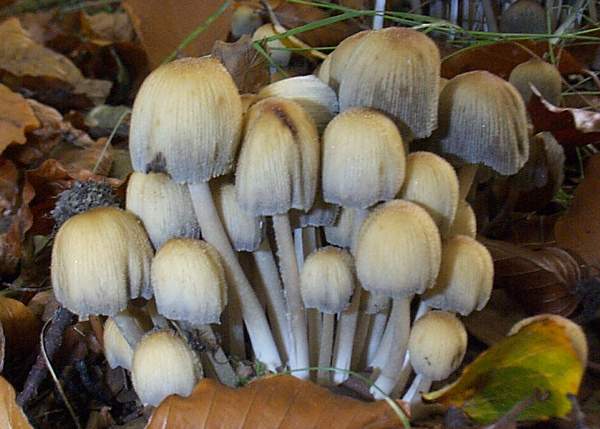
Culinary Notes
The Glistening Inkcap is reported to be edible, but it is not highly regarded.
Reference Sources
Fascinated by Fungi, 2nd Edition, Pat O'Reilly 2016, reprinted by Coch-y-bonddu Books in 2022.
Orton, P.D. & Watling, R. (1979). British Fungus Flora: Agarics and Boleti. Vol 2. Coprinaceae: Coprinus. Royal Botanic Garden: Edinburgh.
Redhead SA, Vilgalys R, Moncalvo J-M, Johnson J, Hopple JS Jr.; Vilgalys, Rytas; Moncalvo, Jean-Marc; Johnson, Jacqui; Hopple, Jr. John S (2001). 'Coprinus Pers. and the disposition of Coprinus species sensu lato.'. Taxon (International Association for Plant Taxonomy (IAPT)) 50 (1): 203–41.
Dictionary of the Fungi; Paul M. Kirk, Paul F. Cannon, David W. Minter and J. A. Stalpers; CABI, 2008
Taxonomic history and synonym information on these pages is drawn from many sources but in particular from the British Mycological Society's GB Checklist of Fungi.
Fascinated by Fungi. Back by popular demand, Pat O'Reilly's best-selling 450-page hardback book is available now. The latest second edition was republished with a sparkling new cover design in September 2022 by Coch-y-Bonddu Books. Full details and copies are available from the publisher's online bookshop...
